Seaweed
| Seaweed |
|---|
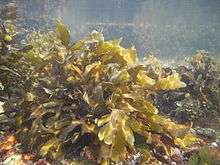 |
| Scientific classification |
|
|
| Included groups |
| Cladistically included but traditionally excluded groups |
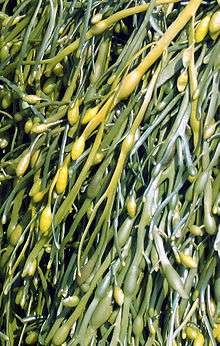
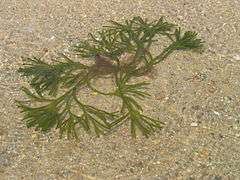
Seaweed or macroalgae refers to several species of macroscopic, multicellular, marine algae.[1]
The term includes some types of red, brown, and green macroalgae. Seaweed may provide excellent opportunities for their industrial exploitation as they could be a source of multiple compounds (i.e. polysaccharides, proteins and phenols) with applications such as food [2][3] and animal feed,[3] pharmaceuticals [4] or fertilizers.
Taxonomy
"Seaweed" is a colloquial term and lacks a formal definition. A seaweed may belong to one of several groups of multicellular algae: the red algae, green algae, and brown algae. As these three groups do not have a common multicellular ancestor, the seaweed are in a polyphyletic group. In addition, some tuft-forming bluegreen algae (Cyanobacteria) are sometimes considered to be seaweed.
Structure
Seaweed's appearance somewhat resembles non-arboreal terrestrial plants.
- thallus: the algal body
- lamina or blade: a flattened structure that is somewhat leaf-like
- sorus: a spore cluster
- on Fucus, air bladder: a flotation-assisting organ on the blade
- on kelp, float: a flotation-assisting organ between the lamina and stipe
- stipe: a stem-like structure, may be absent
- holdfast: a specialized basal structure providing attachment to a surface, often a rock or another alga
- haptera: a finger-like extension of the holdfast anchoring to a benthic substrate
- lamina or blade: a flattened structure that is somewhat leaf-like
The stipe and blade are collectively known as the frond.
Ecology
Two specific environmental requirements dominate seaweed ecology. These are the presence of seawater (or at least brackish water) and the presence of light sufficient to drive photosynthesis. Another common requirement is a firm attachment point, although some genera such as Sargassum and Gracilaria have species that float freely. As a result, seaweed most commonly inhabit the part of a sea that is close to the shore (the littoral zone) and within that zone more frequently on rocky shores than on sand or shingle. Seaweed occupy a wide range of ecological niches. The highest elevation is only wetted by the tops of sea spray, the lowest is several meters deep. In some areas, littoral seaweed can extend several miles out to sea. The limiting factor in such cases is sunlight availability. The deepest living seaweed are some species of red algae.
Others have adapted to live in tidal rock pools. In this habitat, seaweed must withstand rapidly changing temperature and salinity and even occasional drying.[5]
Uses
Seaweed has a variety of purposes, for which it is farmed[6] or foraged from the wild.[7]
At the beginning of 2011, Indonesia produced 3 million tonnes of seaweed and surpassed the Philippines as the world's largest seaweed producer. By 2011, the production was estimated to have reached 10 million tonnes.[8]
Food
Seaweed is consumed by coastal people, particularly in East Asia, e.g. Japan, China, Korea, Taiwan, and Southeast Asia, e.g. Brunei, Singapore, Thailand, Burma, Cambodia, Vietnam, Indonesia, Philippines, and Malaysia, and also in South Africa, Belize, Peru, Chile, the Canadian Maritimes, Scandinavia, South West England,[9] Ireland, Wales, California, and Scotland.
In Asia, Gim (Korean food) (김, Korea), nori (海苔, Japan), zicai (紫菜, China) are sheets of dried Porphyra used in soups, sushi wrap or onigiri (rice balls). Chondrus crispus (commonly known as 'Irish moss' or carrageenan moss) is another red alga used in producing food additives, along with Kappaphycus and gigartinoid seaweed. Porphyra is a red alga used in Wales to make laver. Laverbread, made from oats and the laver, is a popular dish there. In northern Belize, edible seaweed are mixed with milk, nutmeg, cinnamon, and vanilla to make a common beverage affectionately called "dulce" (or "sweet").
Seaweed are also harvested or cultivated for the extraction of alginate, agar and carrageenan, gelatinous substances collectively known as hydrocolloids or phycocolloids. Hydrocolloids have attained commercial significance as food additives.[10] The food industry exploits their gelling, water-retention, emulsifying and other physical properties. Agar is used in foods such as confectionery, meat and poultry products, desserts and beverages and moulded foods. Carrageenan is used in salad dressings and sauces, dietetic foods, and as a preservative in meat and fish products, dairy items and baked goods.
The development of seaweed as an alternative and sustainable source of food and animal feed ingredients depends on the sustainability of the natural resource of raw biomass and on moving the process of feed development from laboratory to industrial scale.[3]
Herbalism

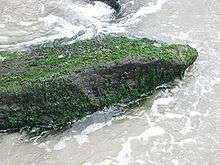
Alginates are commonly used in wound dressings (see alginate dressing), and production of dental moulds. In microbiology research, agar — a plant-based jelly similar to gelatin and made from seaweed — is extensively used as culture medium. Carrageenans, alginates and agaroses (the latter are prepared from agar by purification), with other lesser-known macroalgal polysaccharides, have several important biological activities or applications in biomedicine.
Seaweed extract is used in some diet pills.[11] [12]Other seaweed pills exploit the same effect as gastric banding, expanding in the stomach to make the body feel more full.[13][14]
Filtration
The strong photosynthesis of algae creates a large affinity for nutrients; this allows the seaweed to be used purposely to remove undesired nutrients from water. Nutrients such as ammonia, ammonium nitrate, nitrite, phosphate, iron, copper, as well as CO2 are rapidly consumed by growing seaweed. Reefs and lakes are naturally filtered this way (the seaweed being consumed by fish and invertebrates), and this filtering process is duplicated in artificial seaweed filters such as algae scrubbers.
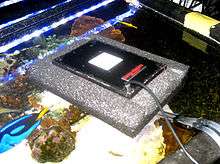
Seaweed (macroalgae), as opposed to phytoplankton (microalgae), is used almost universally for filtration purposes because of the need to be able to easily remove (harvest) the algae from the water, which then removes the nutrients. Microalgae require more processing to separate it from the water than macroalgae does; macroalgae is simply pulled out.
When used for filtration, saltwater algae commonly grows species of Cladophora, Ulva (sea lettuce), and Chaetomorpha. Freshwater filtration applications are useful, too, and will commonly grow species such as Spirogyra.
Other uses
Other seaweed may be used as fertilizer, compost for landscaping, or a means of combating beach erosion through burial in beach dunes.[15] Seaweed is under consideration as a potential source of bioethanol.[16][17]
_algae_that_has_grown_in_an_algae_scrubber.jpg)
Seaweed is an ingredient in toothpaste, cosmetics and paints.[6] Alginates enjoy many of the same uses as carrageenan and are used in industrial products such as paper coatings, adhesives, dyes, gels, explosives and in processes such as paper sizing, textile printing, hydro-mulching and drilling. Research suggests that the Australian seaweed Delisea pulchra may interfere with bacterial colonization.[18] Sulfated saccharides from both red and green algae have been known to inhibit some DNA and RNA enveloped viruses.[4]
Seaweed collecting is the process of collecting, drying and pressing seaweed. It was a popular pastime in the Victorian era and remains a hobby today. In some emerging countries, Seaweed is harvested daily to support communities.
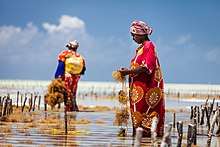
Seaweed is sometimes used to build roofs on houses on Læsø in Denmark [19]
Seaweeds are also used as animal feeds. They have long been grazed by sheep, horses and cattle in Northern Europe. They are currently particularly valuable for fish production.[20] Adding seaweed to livestock feed can substantially reduce methane emissions from cattle.[21]
Photo essay showing women in Zanzibar, Tanzania farming seaweed and making seaweed soap
 Zanzibar's seaweed growers face a changing climate. Here, a farmer tends to her farm in Paje, on the southeast coast of the island.
Zanzibar's seaweed growers face a changing climate. Here, a farmer tends to her farm in Paje, on the southeast coast of the island. Mwanaisha Makame and Mashavu Rum, who have been farming seaweed on beautiful Zanzibar island for 20 years, wade through the low tide to their farm.
Mwanaisha Makame and Mashavu Rum, who have been farming seaweed on beautiful Zanzibar island for 20 years, wade through the low tide to their farm.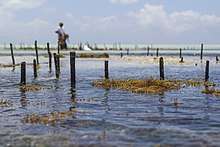 The seaweed grows underwater for 45 days. When it reaches one kilogram, the women pick it and dry it, then pack it in bags to be exported to countries like China, Korea and Vietnam. There, it's used in medicines and shampoos.
The seaweed grows underwater for 45 days. When it reaches one kilogram, the women pick it and dry it, then pack it in bags to be exported to countries like China, Korea and Vietnam. There, it's used in medicines and shampoos. The farmers have a lot of problems due to climate change. Two decades ago, 450 seaweed farmers roamed Paje. Now, only about 150 farmers remain.
The farmers have a lot of problems due to climate change. Two decades ago, 450 seaweed farmers roamed Paje. Now, only about 150 farmers remain. Mwanaisha holds up a healthy clump of seaweed. Then she holds up seaweed the farmers won't be able to use. A hard white substance grows on it - ice-ice disease, caused by higher ocean temperatures and intense sunlight.
Mwanaisha holds up a healthy clump of seaweed. Then she holds up seaweed the farmers won't be able to use. A hard white substance grows on it - ice-ice disease, caused by higher ocean temperatures and intense sunlight.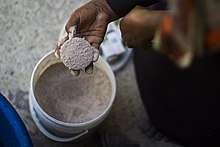 The seaweed farmers learned how to make soap from their seaweed.
The seaweed farmers learned how to make soap from their seaweed. Later in the week, the seaweed farmers will sell their finished soaps in Zanzibar town or to regular local customers. As seaweed levels decline, they have found a way to increase the value of their work.
Later in the week, the seaweed farmers will sell their finished soaps in Zanzibar town or to regular local customers. As seaweed levels decline, they have found a way to increase the value of their work. The finished product - a bar of seaweed soap.
The finished product - a bar of seaweed soap.
Health risks
Rotting seaweed is a potent source of hydrogen sulfide, a highly toxic gas, and has been implicated in some incidents of apparent hydrogen-sulphide poisoning.[22] It can cause vomiting and diarrhea.
The stinging seaweed Microcoleus lyngbyaceus contains several known toxins including lyngbyatoxin-a and debromoaplysiatoxin. Direct skin contact can cause seaweed dermatitis characterized by painful, burning lesions that subsist for several days. [23] [24]
Genera
The following table lists a very few example genera of seaweed.
| Genus | Algae Phylum | Remarks | |
|---|---|---|---|
| Caulerpa | Green | Submerged | |
| Fucus | 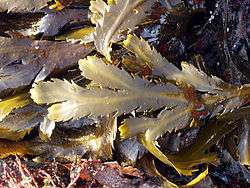 | Brown | In intertidal zones on rocky shores. |
| Gracilaria | Red | Cultivated for food | |
| Laminaria |  | Brown | Also known as kelp, 8–30 m under water, cultivated for food. |
| Macrocystis |  | Brown | Giant kelp, forming floating canopies. |
| Monostroma | Green | ||
| Porphyra | 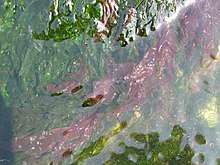 | Red | Intertidal zones in temperate climate. Cultivated for food. |
See also
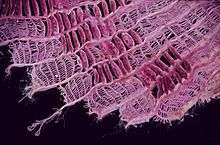
- Algaculture
- Algae fuel
- Aonori, Hijiki, Kombu, Mozuku, Nori, Ogonori, and Wakame - seaweed preparations used in Japan, and occasionally Korea and parts of Oceania
- Cochayuyo, a form of kelp used as a vegetable in Chile
- Sea lettuce
- Seaweed cultivator
- Seaweed dermatitis
References
- ↑ Smith, G.M. 1944. Marine Algae of the Monterey Peninsula, California. Stanford Univ., 2nd Edition.
- ↑ Garcia-Vaquero, M; Rajauria, G; O'Doherty, JV; Sweeney, T (2017). "Polysaccharides from macroalgae: Recent advances, innovative technologies and challenges in extraction and purification". Food Research International. 99 (Pt 3): 1011–1020. doi:10.1016/j.foodres.2016.11.016. hdl:10197/8191. PMID 28865611 – via Elsevier.
- 1 2 3 Garcia-Vaquero, M.; Hayes, M. (2016). "Red and green macroalgae for fish and animal feed and human functional food development". Food Reviews International. 32: 15–45. doi:10.1080/87559129.2015.1041184.
- 1 2 Kazłowski B; Chiu YH; Kazłowska K; Pan CL; Wu CJ (August 2012). "Prevention of Japanese encephalitis virus infections by low-degree-polymerisation sulfated saccharides from Gracilaria sp. and Monostroma nitidum". Food Chem. 133 (3): 866–74. doi:10.1016/j.foodchem.2012.01.106.
- ↑ Lewis, J.R. 1964. The Ecology of Rocky Shores. The English Universities Press Ltd.
- 1 2 "Seaweed farmers get better prices if united". Sun.Star. 2008-06-19. Retrieved 2008-07-16.
- ↑ "Springtime's foraging treats". The Guardian. The Guardian. 2007-01-06. Retrieved 2008-07-16.
- ↑ "RI aims to become world's largest seaweed producer". Waspada.co.id. 2011-04-16. Retrieved 2012-06-28.
- ↑ "Devon Family Friendly - Tasty Seaweed Recipe - Honest!". BBC. 2005-05-25. Retrieved 2012-06-28.
- ↑ Round F.E. 1962 The Biology of the Algae. Edward Arnold Ltd.
- ↑ Hayato Maeda, Masashi Hosokawa, Tokutake Sashima, Katsura Funayama & Kazuo Miyashita (2005). "Fucoxanthin from edible seaweed, Undaria pinnatifida, shows antiobesity effect through UCP1 expression in white adipose tissues". Biochemical and Biophysical Research Communications. 332 (2): 392–397. doi:10.1016/j.bbrc.2005.05.002. PMID 15896707.
- ↑ "phen375". 25 April 2018.
- ↑ "New Seaweed Pill Works Like Gastric Banding". Fox News.
- ↑ Elena Gorgan (6 January 2009). "Appesat, the Seaweed Diet Pill that Expands in the Stomach". softpedia.
- ↑ Rodriguez, Ihosvani (April 11, 2012). "Seaweed invading South Florida beaches in large numbers". South Florida Sun-Sentinel. Retrieved 2012-04-11.
- ↑ "Seaweed Power: Ireland Taps New Energy Source". alotofyada.blogspot.co.uk. 2008-06-24. Retrieved 9 April 2018.
- ↑ Chen, Huihui; Zhou, Dong; Luo, Gang; Zhang, Shicheng; Chen, Jianmin (2015). "Macroalgae for biofuels production: Progress and perspectives". Renewable and Sustainable Energy Reviews. 47: 427–437. doi:10.1016/j.rser.2015.03.086.
- ↑ Francesca Cappitelli & Claudia Sorlini (2008). "Microorganisms attack synthetic polymers in items representing our cultural heritage". Applied and Environmental Microbiology. 74 (3): 564–569. doi:10.1128/AEM.01768-07. PMC 2227722. PMID 18065627.
- ↑ "Seaweed Thatch". naturalhomes.org. Retrieved 9 April 2018.
- ↑ Heuzé V., Tran G., Giger-Reverdin S., Lessire M., Lebas F., 2017. Seaweeds (marine macroalgae). Feedipedia, a programme by INRA, CIRAD, AFZ and FAO. https://www.feedipedia.org/node/78 Last updated on May 29, 2017, 16:46
- ↑ "Seaweed shown to reduce 99% methane from cattle". irishtimes.com. Retrieved 9 April 2018.
- ↑ "Algues vertes: la famille du chauffeur décédé porte plainte contre X" AFP, retrieved 2010-04-22 (in French)
- ↑ https://www.cabdirect.org/cabdirect/abstract/19822902103 "Escharotic stomatitis caused by the "stinging seaweed" Microcoleus lyngbyaceus (formerly Lyngbya majuscula): case report and literature review"
- ↑ https://onlinelibrary.wiley.com/doi/full/10.1111/j.1365-4632.2011.05042.x "Lyngbya dermatitis (toxic seaweed dermatitis)"
Further reading
External links
| Wikimedia Commons has media related to Seaweed. |
- Michael Guiry's Seaweed Site information on all aspects of algae, seaweed and marine algal biology
- SeaweedAfrica, information on seaweed utilisation for the African continent.
- Seaweed. A chemical industry in Brittany, in the past and today.
- AlgaeBase, a searchable taxonomic, image, and utilization database of freshwater, marine and terrestrial algae, including seaweed.
